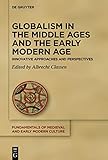Globalism in the Middle Ages and the Early Modern Age : Innovative Approaches and Perspectives / ed. by Albrecht Classen.
Material type: TextSeries: Fundamentals of Medieval and Early Modern Culture ; 27Publisher: Berlin ; Boston : De Gruyter, [2023]Copyright date: ©2023Description: 1 online resource (VII, 643 p.)Content type:
TextSeries: Fundamentals of Medieval and Early Modern Culture ; 27Publisher: Berlin ; Boston : De Gruyter, [2023]Copyright date: ©2023Description: 1 online resource (VII, 643 p.)Content type: - 9783111189079
- 9783111190600
- 9783111190228
- online - DeGruyter
- Issued also in print.
| Item type | Current library | Call number | URL | Status | Notes | Barcode | |
|---|---|---|---|---|---|---|---|
 eBook
eBook
|
Biblioteca "Angelicum" Pont. Univ. S.Tommaso d'Aquino Nuvola online | online - DeGruyter (Browse shelf(Opens below)) | Online access | Not for loan (Accesso limitato) | Accesso per gli utenti autorizzati / Access for authorized users | (dgr)9783111190228 |
Frontmatter -- Contents -- Globalism in the Pre-Modern World? Questions, Challenges, and the Emergence of a New Approach to the Middle Ages and the Early Modern Age -- Global Inferno: Medieval Giants, Monsters, and the Breaching of the Great Barrier -- Swords as Medieval Icons and Early “Global Brands” -- Ecce! A Ninth-Century Isidorean T-O Map Labeled in Arabic -- Going Rogue Across the Globe: International Vagrants, Outlaws, Bandits, and Tricksters from Medieval Europe, Asia, and the Middle East -- Modifying Ancestral Memories in Post-Carolingian West Francia and Post-Tang Wuyue China -- Scalping Saint Peter’s Head: An Interreligious Controversy over a Punishment from Baghdad to Rome (Eighth to Twelfth Centuries) -- A Global Dialogue in al-Kindī’s “A Short Treatise on the Soul” -- Globalism in Paul of Antioch’s Letter to a Muslim Friend and Its Refutation by Ibn Taymiyya -- The Global Fable in the Middle Ages -- Globalism in the Late Middle Ages: The Low German Niederrheinische Orientbericht as a Significant Outpost of a Paradigm Shift. The Move Away from Traditional Eurocentrism -- The Germanic Translations of Lanfranc’s Surgical Works as Example of Global Circulation of Knowledge -- Brick by Brick: Constructing Identity at Don Lope Fernández de Luna’s Parroquieta at La Seo -- Quello assalto di Otranto fu cagione di assai male. First Results of a Study of the Globalization in the Neapolitan Army in the 1480s -- The Diplomat and the Public House: Ioannes Dantiscus (1485–1548) and His Use of the Inns, Taverns, and Alehouses of Europe -- Globalism During the Reign of Queen Elizabeth I -- Between East and West: John Pory’s Translation of Leo Africanus’s Description of Africa -- The Old and the New – Pepper, Bezoar, and Other Exotic Substances in Bohemian Narratives about Distant Lands from the Middle Ages and Early Modern Period (up to the 1560s) -- John Dee and the Creation of the British Empire -- Eberhard Werner Happel: A Seventeenth-Century Cosmographer and Cosmopolitan -- Globalism Before Modern Globalism -- List of Illustrations -- Biographies of the Contributors -- Index
restricted access online access with authorization star
http://purl.org/coar/access_right/c_16ec
Although it is fashionable among modernists to claim that globalism emerged only since ca. 1800, the opposite can well be documented through careful comparative and transdisciplinary studies, as this volume demonstrates, offering a wide range of innovative perspectives on often neglected literary, philosophical, historical, or medical documents. Texts, images, ideas, knowledge, and objects migrated throughout the world already in the pre-modern world, even if the quantitative level compared to the modern world might have been different. In fact, by means of translations and trade, for instance, global connections were established and maintained over the centuries. Archetypal motifs developed in many literatures indicate how much pre-modern people actually shared. But we also discover hard-core facts of global economic exchange, import of exotic medicine, and, on another level, intensive intellectual debates on religious issues. Literary evidence serves best to expose the extent to which contacts with people in foreign countries were imaginable, often desirable, and at times feared, of course. The pre-modern world was much more on the move and reached out to distant lands out of curiosity, economic interests, and political and military concerns. Diplomats crisscrossed the continents, and artists, poets, and craftsmen traveled widely. We can identify, for instance, both the Vikings and the Arabs as global players long before the rise of modern globalism, so this volume promises to rewrite many of our traditional notions about pre-modern worldviews, economic conditions, and the literary sharing on a global level, as perhaps best expressed by the genre of the fable.
Issued also in print.
Mode of access: Internet via World Wide Web.
In English.
Description based on online resource; title from PDF title page (publisher's Web site, viewed 26. Apr 2024)


